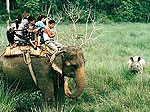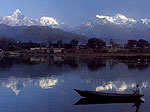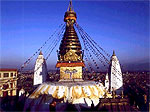|
|
|
| |
| Nepal - Essence of Nepal– 8 Nights and 9 Days. |
Tab 1
Essence of Nepal – 8 Nights and 9 Days.
This 9 days trip will give you the true essence of Nepal. From UNESCO World Heritage sites to the natures perfect bliss and from the heats of the Terai Jungles to the chill of the world’s highest mountain peaks. This tour includes visiting ancient temples and stupas of Nepal. You will take a mountain flight to witness Mt. Everest up close. Jungle safari in Chitwan National Park, drive to Pokhara and visit the ancient city of Kathmandu, Patan and Bhaktapur.
For custom tailored tour packages please contact us.
 Chitwan Jungle Safari
Chitwan Jungle Safari |
 Pokhara
Pokhara |
 Swyambhunath
Swyambhunath |
Tab 2
| DAY |
ACTIVITIES |
| Day 1 |
Arrive at the Tribhuvan International Airport where you meet our representative who will assist you to the hotel.
This day you will be taken to the Swayambhunath stupa.
Swayambhunath - the “Monkey Temple”, the oldest shrine in the world established more than 2000 years ago lies at a distance of 3 KMS west of Kathmandu City. Situated on top of a high hill about 77 M above the level of Kathmandu Valley where legendary Manjushri discovered the lotus growing in the ancient Kathmandu Valley lake, Swayambhunath commands a superb view of the valley below. The four side of this ancient structure are painted with the all – seeing and compassionate eyes of Lord Buddha. Between the eyes is a mystical third eye symbolizing true wisdom. The nose, appearing as an incomplete question mark, is the Nepalese number of one, a symbol of unity.
The evening you will be presented with a typical Newari/ Nepali dinner with folk dance and music at a Nepali speciality resturant. |
| Day 2 |
After breakfast, you will be taken for a sightseeing of the ancient city of Kathmandu and Patan.
Kathmandu City - Although the fertile Kathmandu Valley has been inhabited for thousands of years, its rich and varied cultural legacy essentially began during the 13th century under the Malla Dynasty. Patronized by the nobility, Newar artisans constructed temples, monasteries and elaborate courtyards that constitute a fascinating architectural history. Visit Durbar Square and Teleju Temple with its gilded roofs; the present temple was restored by King Mahendra Malla in 1562. The gate to the Hanuman Dhoka Durbar, the old Royal Palace, is guarded by a statue of Hanuman, the monkey - god, wrapped in a red cloak’ the deity’s face is covered by a thick layer of sindur, a red dust mixed with mustard oil. Stop at House of the Living Goddess where the virgin goddess known as Kumari may look down from one of the upper floor windows. Kathmandu derives its name from the 12th century wood temple of Kasthamandap, said to have been built from a single tree. Walk through the bazaar and labyrinthine back streets of the old city.
Patan City, the City of arts and architecture founded in 250 A.D. and also known as Lalitpur. It is renowned for its fine works in bronze, silver and copper. Visit the Durbar Square, Royal Baths, Mahaboudha, Krishna Mandir and Hiranya Varna Mahabihar (the Golden Temple). |
| Day 3 |
After breakfast you will be taken for a scenic mountain flight.
Mountain Flight - Transfer to airport for early morning Mountain Flight. This is an enchanting 50 minutes flight over the world's highest mountain range where you can enjoy close-up views of Mt. Everest and other Himalayan giants like Ama Dablam, Lhotse etc.
After your mountain flight, you will take another flight and fly down to Bharatpur (Chitwan).
Chitwan National Park - This is Nepal’s first and most famous National Park, which is in the inner terai of central Nepal and is the best-protected area in the country. It covers an area of 932 sq. meter and includes hilly areas of Siwalik range covered by sal forest. This ecologically diverse area is the last remaining home for over 300 of the endangered Asian one horned rhinoceros and the largest population of the elusive and rare Royal Bengal tiger. Besides these there are leopards, sloth bears, spotted deers (chittal), wild dogs, wild boars, rhesus monkeys, white stockinged gaur (world’s largest wild cattle), grey langur monkeys, small wild cats and many small animals. It is also full of a great variety of flora and fauna. The swampy areas and numerous lakes of Chitwan are home for marsh crocodiles and in a stretch of the Narayani river is found one of the few remaining populations of the rare and the endangered Gharial(Gangetic crocodile). Also four species of water dolphins are found here. It is a paradise for the bird watchers also. Several species of woodpeckers, Bengal florican, hornbills, red headed trogons and the winter birds, such as, pintails, bar headed geese, water fowl and Brahminy ducks among many other cold weather visitors are drawn here by the sanctuary of the rivers. During the summer months, the forest is full of nesting migrants, such as the Indian pitta, the paradise flycatchers and parakeets. The park offers more than 450 species of birds.
Transfer to the lodge
After lunch Commence Jungle activities such as elephant back safari, jungle/nature walk, bird watching and boat ride etc in Chitwan National Park
|
| Day 4 |
You will spent your entire day participating in the various Jungle activities.
|
| Day 5 |
Following an early morning Jungle activity, you will be served breakfast after which you will take a drive to Pokhara.
Pokhara - Situated in the Valley of Seti River, Pokhara commands one of the most spectacular views of mountains in Nepal since no major range intervenes between the Pokhara Valley and the main range of the Himalayas.
Pokhara's unique charm derives from its all-year-round splendid climate and its stunning close views of magnificent Machhapuchare or Fish Tail Mountain (6997m), and the mighty Annapurnas. Enhancing Pokhara's appeal is Phewa lake at the foot of gigantic peaks a mere 25 km away. If man-made cultural treasures make Kathmandu a city of the gods, Pokhara in contrast celebrates mountains and its people, most famously the Gurungs and Magars, who form the core of the renowned Gurkha soldiers.
Here one encounters magical scenes that memory will never abandon, such as the town's quaint bazaars brimming with colourful wares transported on sturdy mules along ancient trade routes and escorted by equally colourful highlands.
Sightseeing tour of Pokhara including a visit to Brindabasini Temple, Davis falls, Seti Gorge.
Davis Falls: This falls has been made to be an outstanding attraction in many brochures and guidebooks. But you are likely to be disappointed unless you visit there during the rainy season. The water of Pardi Khola, which drain Lake Phewa, fall underground and disappears at Davis Falls. There is an interesting legend associated with this falls (which is probably true). During the late fifties, a Swiss couple were visiting Pokhara on their honeymoon trip and happened to take bath in the waters of the fall. The gates of the dam were opened unexpectedly and the woman was washed away and drowned. It was after the drowned woman that the locals named this fall.
Bindebasani Temple: The most famous temple of Pokhara is situated in the old part of the city. It was constructed by the Rajas of Kaski before unification of Nepal. It was renovated in 1965. the main deity is the goddess Druga. There is a major festival during the Dasain in October in which animals such as goat are sacrificed. After visiting the temple you can move around the old market surrounding the temple. This is also the starting point of trek to Sarangkot. There are a number of old buildings but these are not as old as in Kathmandu valley. These are perhaps a century old. Some old buildings at Ramkrishna and Bhairab Toles are planned to be preserved in “monument zone” to be set up in the area.
Seti Gorge: The deep gorge made by Seti River (which means ‘white’ in Nepali) along the eastern side of Pokhara city could be as much as 40 meters and has been made a tourist attraction in the city. The gorge is visible from different bridges in the city – the most famous being Mahendra Pool in city center.
|
| Day 6 |
Early morning Sunrise trip to Sarankot.
Day hike to Sarankot. This is a short but rewarding trek starts with a quick drive to Bindeswari Temple followed by a three hour sustained climb of 2,000 ft. up the ridgeline west of Pokhara. From Sarankot, which literally means "site of an old fort", you are afforded a stunning view of the Annapurna range and in particular of the sacred Machapuchare more commonly known as "Fishtail". After an hour's lunch break in which your guide will identify the panoply of famous peaks, you will descend at a leisurely pace back to the Temple before returning to your hotel.
Then you will be taken for a boat ride on the Phewa Lake and enjoy the scenery as it unfolds before your eyes. You may also visit the typical small pagoda style temple dedicated to Goddess Varahi built on a small island. It is peaceful and romantic.
|
| Day 7 |
This day after breakfast, you will drive back to Kathmandu and then more further to Nagarkot.
Nagarkot – Located 30 KMS east of Kathmandu on the valley rim is a favorite getaway for those who seek Himalayan scenery and rural serenity. Nagarkot is situated at an elevation of 2175 M and offers possibly the best display of the Himalaya in a clear day while remaining in the proximity of the valley. One can see 5 of the world’s 10 tallest peaks including Ganesh Himal (7429 M), Langtang (7234 M), Gan Chenpo (6397 M), Shishapangma (8013 M), Gur Karpori (6874 M), Dorje Lhakpa (6988 M), Lenpo Gang (7083 M), Phurbi Chyachu (6637 M), Makalu (8463 M), Cho Oyu (8201 M), Lhotse (8516 M), Manaslu (8163 M) etc and above all a glimpse of a dark shape in the back is visible in a very clear day and that is Sagarmatha (Everest – 8848 M).
Rest of your day, you are left at your leisure. |
| Day 8 |
After breakfast take a drive to a world heritage site of Changunarayan Temple.
ChanguNarayan - The temple of Changu Narayan, built on a hilltop some 12 kilometers east of Kathmandu dates back to the 4th century. As you walk through the main entrance you are greeted by a couple of stone elephants, then encounter a twin roofed pagoda and the main two-tiered temple. In the center of the main temple is Vishnu, with 10 arms going through the different layers of the universe. This beautiful priceless piece of the 5th or 6th century is surrounded by half a dozen more images dating back to the 9th century. There is also an image of Garuda, the mythical bird that serves as Vishnus heavenly vehicle. Besides, it is one of the oldest and most important Licchavi inscriptions in the Valley.
After visiting Changunarayan proceed to Bhaktapur to explore the city of devotees:
Bhaktapur, home of medieval art and architecture, also known as the 'City of Devotees' and for its majestic monuments, colourful festivals and the native Newars, best known for their long history of craftsmanship, the ancient city is also variously known as the “Living Heritage”. Bhaktapur is more like an open museum and the ambience here is such that it instantly transports visitors back into lost civilization the moment they step into Bhaktapur. Tread the 17th century along cobbled pavements and marvel at the ancient architectures. Bhaktapur has its gem in the Durbar Square - a World Heritage Site listed by UNESCO. Strewn with unique palaces, temples and monasteries best admired for their exquisite artworks in wood, metal and stone, the palatial enclave has bewitched pilgrims and travelers for centuries. Adding to the mesmerizing environs is the snow capped Himalayan range that makes the backdrop of the city. Visit the Lion Gate, Datttraya Temple, Peacock window, Nyatapola, Pottery, the Picture Gallery, the Golden Gate, and the Palace of Fifty five Windows.
Also visit the famous Hindu temple Of Pashupatinath followed by a visit to Boudhanath Stupa
Pashupatinath, the most sacred of all Hindu temples in Nepal situated on the banks of the holy Bagmati River. Non - Hindus are not allowed to enter the temple precincts but may look into premises from the opposite bank. It draws tens of thousands of pilgrims and devotees from Nepal and India during the festival of Mahashivaratri (the night of Lord Shiva).
Boudhanath,-possibly the world's largest Buddhist stupa and a site of great veneration for Buddhists. Around the stupa have sprung up number of monasteries of the different sects of Tibetan Buddhism including one (on the west side of the stupa) that houses an enormous seated statue of Maitreya Buddha splendidly adorned.
|
| Day 9 |
After breakfast you will be left on your own until departure time. Then you will be taken to the airport for your final departure.
For custom tailored tour packages please contact us. |
Tab 3
|
|
 |
Kathmandu Culture Explore
- 3 Nights and 4 Days
This 3 Night/4 Days tour package covers all the major city in Kathmandu Valley like Kathmandu, Bhaktapur, Patan ...
Read more...
|
|
 |
Historical, Heritage Sites & Beyond - 6 Nights and 7 Days
Kathmandu is home to some of the worlds best ancient architecture. This 6 nights & 7 days tour packages covers not just the historic site, but ...
Read more...
|
|
|
| |
 |
|
|
